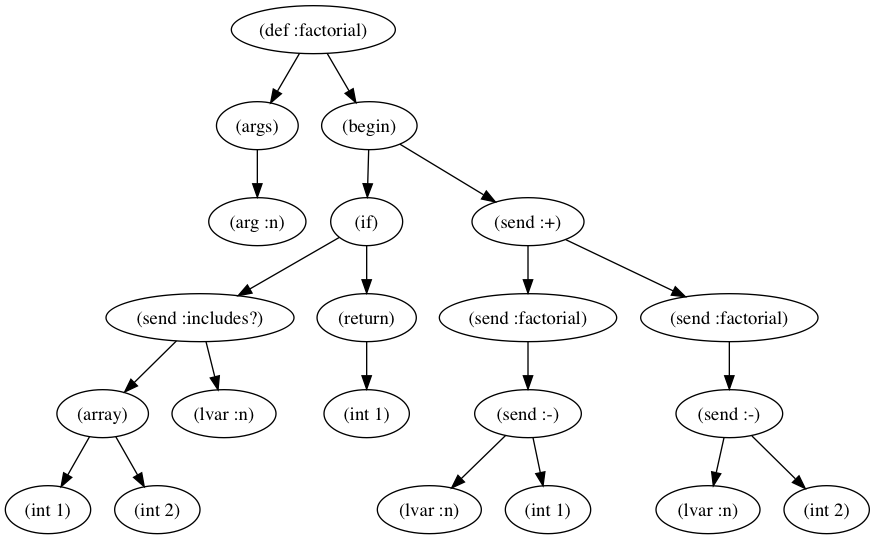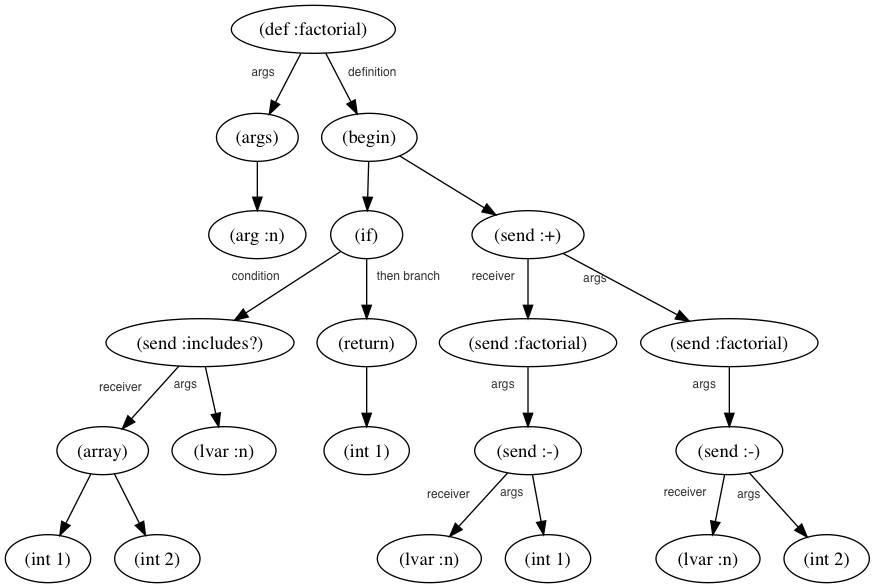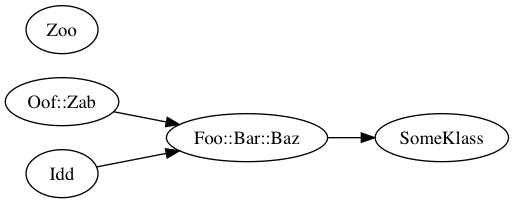Growing (not only) trees. Part 2
In the first article part we already learned how to render a tree. Let’s try to use this knowledge on practice. We don’t want to solve something trivial, so we should select suitable problem. So, we will render class relations diagram in Rails application. And there is no any boring models diagrams like https://github.com/preston/railroady or https://github.com/voormedia/rails-erd, no! We will make it with help of the syntax analyzing.
So, the syntax analyzing consists of two parts – tokenization (building AST) and analyzing itself. Let’s start to dive in AST analyzing from reviewing factorial function implementation AST. As AST is actually Tree and we already know how to render trees, we will use knowledge from the first part. It’s better to use canonical Visitor pattern for AST traversing, but we do not want to extend existing AST classes and implement less smart variant:
require 'parser/current'
class ASTRenderer
def initialize(tree)
@tree = tree
end
def call
result = []
result << "digraph graphname {"
bfs(@tree).each do |node|
result << ["#{node.object_id}", %Q{[label="#{present(node)}"]}].join(" ")
node.children.each do |child|
next unless child.is_a?(Parser::AST::Node)
result << [[node.object_id, child.object_id].join(" -> ")].join
end
end
result << "}"
result.join("\n")
end
private
#TODO: Add missing node types rendering
def present(node)
return node.to_s unless node.is_a?(Parser::AST::Node)
case node.type
when :begin then "(begin)"
when :if then "(if)"
when :array then "(array)"
when :send then "(send :#{node.to_a[1]})"
when :lvar then "(lvar :#{node.to_a[0]})"
when :def then "(def :#{node.to_a[0]})"
when :str then "(str :#{node.to_a[0]})"
when :args then "(args)"
when :return then "(return)"
else node.to_s
end
end
def bfs(node)
queue = [node]
discovered = []
while queue.length > 0 do
current = queue.shift
next unless current.is_a?(Parser::AST::Node)
discovered << current
current.children.each do |child|
queue << child if child
end
end
discovered
end
end
source_code = <<RUBY
def factorial(n)
return 1 if [1, 2].includes?(n)
factorial(n - 1) + factorial(n - 2)
end
RUBY
ast = Parser::CurrentRuby.parse(source_code)
puts ASTRenderer.new(ast).call
Result:

Result with comments (you could receive this version by minor changing code above):

Factorial function source code:
def factorial(n)
return 1 if [1, 2].includes?(n)
factorial(n - 1) + factorial(n - 2)
end
As you can see, there is no such changes comparing with the code from the first part. There is no rendering actually binary tree code, we are ignoring non-Parser::AST::Node nodes and change code which presents node internal value. Even on this small example we can see, that it’s really hard to understand what exactly this code doing on high level because there is too much details. But we could cut off excess information.
Let’s review node with class definition:
class Foo < Bar
def body; end
end
s(:class,
s(:const, nil, :Foo),
s(:const, nil, :Bar),
s(:def, :body,
s(:args), nil))
In code above, s – is s-expressions, notation for nested lists. Let’s analyze class node content. There are three arguments in class node: first (s(:const, nil, :Foo)) – node with constant which will be pointer for this class, second (s(:const, nil, :Bar)) – node with constant, which is pointer for parent class, and last one (s(:def, :body, s(:args), nil))) – class body definition, in code above we are using body method.
Let’s start from displaying all defined classes. We will catch events on class definitions and store all defined classes in the special instance variable.
class KlassDefinitionsProcessor < Parser::AST::Processor
attr_reader :klass_definitions
def initialize(*)
super
@klass_definitions = []
end
def on_class(node)
klass_konst, _parrent, _body = *node
_nested_konst, konst_name = *klass_konst
@klass_definitions << konst_name
super
end
end
It’s pretty simple, we are using already defined AST::Processor, which process our AST. We add code which responsible for class definitions storing. Let’s run our code:
source_code = <<RUBY
class Foo; end
class Bar; end
RUBY
ast = Parser::CurrentRuby.parse(source_code)
processor = KlassDefinitionsProcessor.new
processor.process(ast)
p processor.klass_definitions
# => [:Foo, :Bar]
Nice for start, but, as always, there are a lot of troubles ahed. What if we need to receive name of class with namespace, like Foo::Bar::Baz? Current code will amend namespace part, so we need to fix it. Instead of receiving last constant in class definition we could simply use this node mapping on source code with klass_konst.loc.expression.source.
So, our new code:
def on_class(node)
klass_konst, _parrent, _body = *node
@klass_definitions << klass_konst.loc.expression.source
super
end
class Foo::Bar::Baz; end
class Oof::Zab; end
# => ["Foo::Bar::Baz", "Oof::Zab"]
Ok, let’s finally start why are we here – building relations diagram. We will add catching events on constants processing to the existing code for this:
def on_const(node)
konst_name = node.loc.expression.source
super
end
Not to hard, but it’s impossible to determine in which class we are receiving this constants. It will be nice to receive not only children of each node, but parents. But it’s impossible (again!) to make it by standard AST processing tools, because AST designed for top-bottom traversing, but we need bottom-top. From another side, we could push information about current processing node on every step and pop it when we are living node. Oh, it’s very similar to actually code executing with all this call stacks and so on, the main thing is not to go too far with nesting and not to receive stack overflow :). The code is very simple, every time when AST::Processor processing node it calls method process, so we need to redefine it a little:
def process(node)
@nesting.push(node)
super
@nesting.pop
end
Ok, now our live is muuuuuuuuuuuuuuch easier. Muuuuuuch! For example, we could receive current node parent:
def parent
@nesting.last(2).first
end
and find in which class we are processing current node:
def context_klass
@nesting.reverse.select { |x| x.type == :class }.first
end
And will make our live easier:
def klass_name_for(node)
klass_konst, _, _ = *node
source_for(klass_konst)
end
def source_for(node)
node.loc.expression.source
end
Our new code. We are storing class definitions and storing used constants:
def on_class(node)
@klass_definitions << klass_name_for(node)
super
end
def on_const(node)
konst_name = source_for(node)
current_klass = klass_name_for(context_klass)
(@klass_dependencies[current_klass] ||= []) << konst_name
super
end
Run this code on new test example:
class Foo::Bar::Baz; end
class Oof::Zab; def call; Foo::Bar::Baz.new; end; end
# processor.klass_dependencies
# => {
# "Foo::Bar::Baz"=>["Foo::Bar::Baz", "Foo::Bar", "Foo"],
# "Oof::Zab"=>["Oof::Zab", "Oof", "Foo::Bar::Baz", "Foo::Bar", "Foo"]
# }
Not exactly what we expected, though… As we saw before, nested constants is commonly used and on_const method will be triggered for each constant. Additionally we could see, that every class has pointer on self, because constant, which is class name, is defining inside node with class definition. So, we need to ignore this two cases: when parent node is constant (nested constants) or class definition. Fix for our function:
def on_const(node)
unless %i[class const].include?(parent.type)
konst_name = source_for(node)
current_klass = klass_name_for(context_klass)
(@klass_dependencies[current_klass] ||= []) << konst_name
end
super
end
class Foo::Bar::Baz; end
class Oof::Zab; def call; Foo::Bar::Baz.new; end; end
# {"Oof::Zab"=>["Foo::Bar::Baz"]}
Ok, something more complex:
class SomeKlass; end
class Foo::Bar::Baz; def call; SomeKlass.new end; end
SomeKlass.new
class Oof::Zab; def call; Foo::Bar::Baz.new; end; end
class Idd; def call; Foo::Bar::Baz.new; end; end
class Zoo; end
# relations.rb:47:in `source_for': undefined method `loc' for nil:NilClass (NoMethodError)
Pretty expected, we are calling SomeKlass.new outside of context, so current_klass is nil. Let’s fix it and run again:
def on_const(node)
unless %i[class const].include?(parent.type)
konst_name = source_for(node)
if context_klass
current_klass = klass_name_for(context_klass)
(@klass_dependencies[current_klass] ||= []) << konst_name
end
end
super
end
New result:
processor.klass_dependencies # => {"Foo::Bar::Baz"=>["SomeKlass"], "Oof::Zab"=>["Foo::Bar::Baz"], "Idd"=>["Foo::Bar::Baz"]}
processor.klass_definitions # => ["SomeKlass", "Foo::Bar::Baz", "Oof::Zab", "Idd", "Zoo"]
Oh, we have something to render! So, Graphivz to the rescue. Let’s write class for relations graph rendering as before but in functional style without states and mutations:
class GraphRenderer
def initialize(relations, klasses)
@relations = relations
@klasses = klasses
end
def call
[
begin_header,
klasses_info,
relations_info,
end_header
].flatten.join("\n")
end
private
def begin_header
[
%(digraph graphname {),
%(rankdir="LR")
]
end
def klasses_info
@klasses.map do |klass|
[wrap(klass), %Q{[label="#{klass}"]}].join(" ")
end
end
def relations_info
@relations.map do |klass, dependents|
dependents.map do |child|
[wrap(klass), wrap(child)].join(' -> ')
end
end
end
def end_header
[
%(})
]
end
def wrap(text)
'"' + text + '"'
end
end

Ok, nice for start, but… Ruby has namespaces resolving mechanism.
module A
module B
class C
end
end
end
module A
class D
def call
B::C.new
end
end
end
class E
def call
A::B::C.new
end
end
# E.new.call # => #<A::B::C:0x007f9b0b835768>
# A::D.new.call # => #<A::B::C:0x007f9b0b875250>
But for our code D and E classes depend on different classes:
processor.klass_dependencies # => {"D"=>["B::C"], "E"=>["A::B::C"]}
processor.klass_definitions # => ["C", "D", "E"]
This problem we will solve in the next chapter.